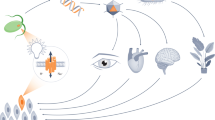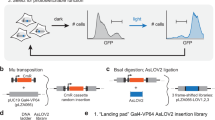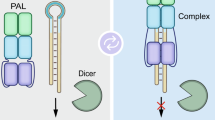Abstract
Genetically encoded tools for the regulation of endogenous molecules (RNA, DNA elements and protein) are needed to study and control biological processes with minimal interference caused by protein overexpression and overactivation of signaling pathways. Here we focus on light-controlled optogenetic tools (OTs) that allow spatiotemporally precise regulation of gene expression and protein function. To control endogenous molecules, OTs combine light-sensing modules from natural photoreceptors with specific protein or nucleic acid binders. We discuss OT designs and group OTs according to the principles of their regulation. We outline characteristics of OT performance, discuss considerations for their use in vivo and review available OTs and their applications in cells and in vivo. Finally, we provide a brief outlook on the development of OTs.
This is a preview of subscription content, access via your institution
Access options
Access Nature and 54 other Nature Portfolio journals
Get Nature+, our best-value online-access subscription
$29.99 / 30 days
cancel any time
Subscribe to this journal
Receive 12 print issues and online access
$259.00 per year
only $21.58 per issue
Buy this article
- Purchase on Springer Link
- Instant access to full article PDF
Prices may be subject to local taxes which are calculated during checkout





Similar content being viewed by others
References
Chow, B. Y. & Boyden, E. S. Optogenetics and translational medicine. Sci. Transl. Med. 5, 177ps175 (2013).
Goglia, A. G. & Toettcher, J. E. A bright future: optogenetics to dissect the spatiotemporal control of cell behavior. Curr. Opin. Chem. Biol. 48, 106–113 (2019).
Rost, B. R., Schneider-Warme, F., Schmitz, D. & Hegemann, P. Optogenetic tools for subcellular applications in neuroscience. Neuron 96, 572–603 (2017).
Leopold, A. V. & Verkhusha, V. V. Light control of RTK activity: from technology development to translational research. Chem. Sci. 11, 10019–10034 (2020).
Mansouri, M., Strittmatter, T. & Fussenegger, M. Light-controlled mammalian cells and their therapeutic applications in synthetic biology. Adv. Sci. 6, 1800952 (2018).
Han, H. A., Pang, J. K. S. & Soh, B.-S. Mitigating off-target effects in CRISPR/Cas9-mediated in vivo gene editing. J. Mol. Med. 98, 615–632 (2020).
Gibson, T. J., Seiler, M. & Veitia, R. A. The transience of transient overexpression. Nat. Methods 10, 715–721 (2013).
Brechun, K. E., Arndt, K. M. & Woolley, G. A. Strategies for the photo-control of endogenous protein activity. Curr. Opin. Struct. Biol. 45, 53–58 (2017).
Marschall, A. L. J. & Dübel, S. Antibodies inside of a cell can change its outside: can intrabodies provide a new therapeutic paradigm? Comput. Struct. Biotechnol. J. 14, 304–308 (2016).
Hamley, I. W. Small bioactive peptides for biomaterials design and therapeutics. Chem. Rev. 117, 14015–14041 (2017).
Richter, F. et al. Engineering of temperature- and light-switchable Cas9 variants. Nucleic Acids Res. 44, 10003–10014 (2016).
Richter, F. et al. Switchable Cas9. Curr. Opin. Biotechnol. 48, 119–126 (2017).
Nihongaki, Y., Kawano, F., Nakajima, T. & Sato, M. Photoactivatable CRISPR–Cas9 for optogenetic genome editing. Nat. Biotechnol. 33, 755–760 (2015).
Nihongaki, Y., Yamamoto, S., Kawano, F., Suzuki, H. & Sato, M. CRISPR–Cas9-based photoactivatable transcription system. Chem. Biol. 22, 169–174 (2015).
Polstein, L. R. & Gersbach, C. A. A light-inducible CRISPR–Cas9 system for control of endogenous gene activation. Nat. Chem. Biol. 11, 198–200 (2015).
Shcherbakova, D. M., Stepanenko, O. V., Turoverov, K. K. & Verkhusha, V. V. Near-infrared fluorescent proteins: multiplexing and optogenetics across scales. Trends Biotechnol. 36, 1230–1243 (2018).
Hoffmann, M. D., Bubeck, F., Eils, R. & Niopek, D. Controlling cells with light and LOV. Adv. Biosyst. 2, 1800098 (2018).
Kichuk, T. C., Carrasco-López, C. & Avalos, J. L. Lights up on organelles: optogenetic tools to control subcellular structure and organization. Wiley Interdiscip. Rev. Syst. Biol. Med. 13, e1500 (2021).
Dagliyan, O. et al. Rational design of a ligand-controlled protein conformational switch. Proc. Natl Acad. Sci. USA 110, 6800–6804 (2013).
Dagliyan, O. et al. Engineering extrinsic disorder to control protein activity in living cells. Science 354, 1441–1444 (2016).
Guntas, G. et al. Engineering an improved light-induced dimer (iLID) for controlling the localization and activity of signaling proteins. Proc. Natl Acad. Sci. USA 112, 112–117 (2015).
Yazawa, M., Sadaghiani, A. M., Hsueh, B. & Dolmetsch, R. E. Induction of protein–protein interactions in live cells using light. Nat. Biotechnol. 27, 941–945 (2009).
Zoltowski, B. D. et al. Conformational switching in the fungal light sensor Vivid. Science 316, 1054–1057 (2007).
Kawano, F., Suzuki, H., Furuya, A. & Sato, M. Engineered pairs of distinct photoswitches for optogenetic control of cellular proteins. Nat. Commun. 6, 6256 (2015).
Kennedy, M. J. et al. Rapid blue-light-mediated induction of protein interactions in living cells. Nat. Methods 7, 973–975 (2010).
Taslimi, A. et al. An optimized optogenetic clustering tool for probing protein interaction and function. Nat. Commun. 5, 4925 (2014).
Che, D. L., Duan, L., Zhang, K. & Cui, B. The dual characteristics of light-induced cryptochrome 2, homo-oligomerization and heterodimerization, for optogenetic manipulation in mammalian cells. ACS Synth. Biol. 4, 1124–1135 (2015).
Lu, X., Shen, Y. & Campbell, R. E. Engineering photosensory modules of non-opsin-based optogenetic actuators. Int. J. Mol. Sci. 21, 6522 (2020).
Zhou, X. X., Fan, L. Z., Li, P., Shen, K. & Lin, M. Z. Optical control of cell signaling by single-chain photoswitchable kinases. Science 355, 836–842 (2017).
Shemetov, A. A., Oliinyk, O. S. & Verkhusha, V. V. How to increase brightness of near-infrared fluorescent proteins in mammalian cells. Cell Chem. Biol. 24, 758–766 (2017).
Kaberniuk, A. A., Shemetov, A. A. & Verkhusha, V. V. A bacterial phytochrome-based optogenetic system controllable with near-infrared light. Nat. Methods 13, 591–597 (2016).
Redchuk, T. A., Omelina, E. S., Chernov, K. G. & Verkhusha, V. V. Near-infrared optogenetic pair for protein regulation and spectral multiplexing. Nat. Chem. Biol. 13, 633–639 (2017).
Ryu, M.-H. & Gomelsky, M. Near-infrared light responsive synthetic c-di-GMP module for optogenetic applications. ACS Synth. Biol. 3, 802–810 (2014).
Shao, J. et al. Synthetic far-red light-mediated CRISPR–dCas9 device for inducing functional neuronal differentiation. Proc. Natl Acad. Sci. USA 115, E6722–E6730 (2018). This paper demonstrates the power of deeply penetrating nontoxic NIR light to control optogenetic systems for activation of gene expression. Development of simpler NIR systems will overcome limitations of the reported multicomponent system.
Wilton, E. E., Opyr, M. P., Kailasam, S., Kothe, R. F. & Wieden, H. J. sdAb-DB: the Single Domain Antibody Database. ACS Synth. Biol. 7, 2480–2484 (2018).
Konermann, S. et al. Optical control of mammalian endogenous transcription and epigenetic states. Nature 500, 472–476 (2013). This paper describes one of the first optogenetic systems for control of endogenous genes.
Redchuk, T. A. et al. Optogenetic regulation of endogenous proteins. Nat. Commun. 11, 605 (2020). This paper describes a technique for optogenetic control of endogenous proteins using intact iBs. This control is achieved by using light-induced intracellular relocalization of OTs and their target proteins.
Gil, A. A. et al. Optogenetic control of protein binding using light-switchable nanobodies. Nat. Commun. 11, 4044 (2020). This paper describes a means for optogenetic control of nanobody affinity, which was achieved by insertion of the light-sensing AsLOV2 domain in specific loops in the nanobody.
Yu, D. et al. Optogenetic activation of intracellular antibodies for direct modulation of endogenous proteins. Nat. Methods 16, 1095–1100 (2019). This paper reports engineering of light-controlled nanobodies, which are reconstituted from split fragments upon illumination.
Muyldermans, S. Nanobodies: natural single-domain antibodies. Annu. Rev. Biochem. 82, 775–797 (2013).
Zuo, J. et al. Institute Collection and Analysis of Nanobodies (iCAN): a comprehensive database and analysis platform for nanobodies. BMC Genomics 18, 797 (2017).
Chandler, P. G. & Buckle, A. M. Development and differentiation in monobodies based on the fibronectin type 3 domain. Cells 9, 610 (2020).
Škrlec, K., Štrukelj, B. & Berlec, A. Non-immunoglobulin scaffolds: a focus on their targets. Trends Biotechnol. 33, 408–418 (2015).
Minkiewicz, P., Iwaniak, A. & Darewicz, M. BIOPEP-UWM database of bioactive peptides: current opportunities. Int. J. Mol. Sci. 20, 5978 (2019).
Wang, J. et al. StraPep: a structure database of bioactive peptides. Database 2018, bay038 (2018).
Wang, Y. et al. NeuroPep: a comprehensive resource of neuropeptides. Database 2015, bav038 (2015).
Jayakanthan, M. et al. ZifBASE: a database of zinc finger proteins and associated resources. BMC Genomics 10, 421 (2009).
Fu, F. & Voytas, D. F. Zinc Finger Database (ZiFDB) v2.0: a comprehensive database of C2H2 zinc fingers and engineered zinc finger arrays. Nucleic Acids Res. 41, D452–D455 (2012).
Abudayyeh, O. O. et al. RNA targeting with CRISPR–Cas13. Nature 550, 280–284 (2017).
Niopek, D., Wehler, P., Roensch, J., Eils, R. & Di Ventura, B. Optogenetic control of nuclear protein export. Nat. Commun. 7, 10624 (2016).
Zhou, X. X. et al. A single-chain photoswitchable CRISPR–Cas9 architecture for light-inducible gene editing and transcription. ACS Chem. Biol. 13, 443–448 (2018).
Stone, O. J. et al. Optogenetic control of cofilin and αTAT in living cells using Z-lock. Nat. Chem. Biol. 15, 1183–1190 (2019).
Yamada, M., Nagasaki, S. C., Ozawa, T. & Imayoshi, I. Light-mediated control of gene expression in mammalian cells. Neurosci. Res. 152, 66–77 (2020).
Ma, G. et al. Optogenetic engineering to probe the molecular choreography of STIM1-mediated cell signaling. Nat. Commun. 11, 1039 (2020).
Repina, N. A. et al. Engineered illumination devices for optogenetic control of cellular signaling dynamics. Cell Rep. 31, 107737 (2020).
Tyssowski, K. M. & Gray, J. M. Blue light increases neuronal activity-regulated gene expression in the absence of optogenetic proteins. eNeuro 6, ENEURO.0085-19.2019 (2019).
Carrasco-Lopez, C. et al. Development of light-responsive protein binding in the monobody non-immunoglobulin scaffold. Nat. Commun. 11, 4045 (2020).
Wehler, P. & Di Ventura, B. Engineering optogenetic control of endogenous p53 protein levels. Appl. Sci. 9, 2095 (2019).
Pazgier, M. et al. Structural basis for high-affinity peptide inhibition of p53 interactions with MDM2 and MDMX. Proc. Natl Acad. Sci. USA 106, 4665–4670 (2009).
Yi, J. J., Wang, H., Vilela, M., Danuser, G. & Hahn, K. M. Manipulation of endogenous kinase activity in living cells using photoswitchable inhibitory peptides. ACS Synth. Biol. 3, 788–795 (2014).
Cunniff, B., McKenzie, A. J., Heintz, N. H. & Howe, A. K. AMPK activity regulates trafficking of mitochondria to the leading edge during cell migration and matrix invasion. Mol. Biol. Cell 27, 2662–2674 (2016).
Murakoshi, H. et al. Kinetics of endogenous CaMKII required for synaptic plasticity revealed by optogenetic kinase inhibitor. Neuron 94, 690 (2017).
Schmidt, D., Tillberg, P. W., Chen, F. & Boyden, E. S. A fully genetically encoded protein architecture for optical control of peptide ligand concentration. Nat. Commun. 5, 3019 (2014).
Rao, M. V., Chu, P. H., Hahn, K. M. & Zaidel-Bar, R. An optogenetic tool for the activation of endogenous diaphanous-related formins induces thickening of stress fibers without an increase in contractility. Cytoskeleton 70, 394–407 (2013).
Baarlink, C., Wang, H. & Grosse, R. Nuclear actin network assembly by formins regulates the SRF coactivator MAL. Science 340, 864–867 (2013).
Paonessa, F. et al. Regulation of neural gene transcription by optogenetic inhibition of the RE1-silencing transcription factor. Proc. Natl Acad. Sci. USA 113, E91–E100 (2016).
He, L. et al. Near-infrared photoactivatable control of Ca2+ signaling and optogenetic immunomodulation. eLife 4, e10024 (2015).
Kim, S. et al. Non-invasive optical control of endogenous Ca2+ channels in awake mice. Nat. Commun. 11, 210 (2020).
Kyung, T. et al. Optogenetic control of endogenous Ca2+ channels in vivo. Nat. Biotechnol. 33, 1092–1096 (2015).
Jeon, D. et al. Observational fear learning involves affective pain system and Cav1.2 Ca2+ channels in ACC. Nat. Neurosci. 13, 482–488 (2010).
Redchuk, T. A., Kaberniuk, A. A. & Verkhusha, V. V. Near-infrared light-controlled systems for gene transcription regulation, protein targeting and spectral multiplexing. Nat. Protoc. 13, 1121–1136 (2018).
Redchuk, T. A., Karasev, M. M., Omelina, E. S. & Verkhusha, V. V. Near-infrared light-controlled gene expression and protein targeting in neurons and non-neuronal cells. Chembiochem 19, 1334–1340 (2018).
Yumerefendi, H. et al. Control of protein activity and cell fate specification via light-mediated nuclear translocation. PLoS ONE 10, e0128443 (2015).
Deng, W. et al. Tunable light and drug induced depletion of target proteins. Nat. Commun. 11, 304 (2020).
Bubeck, F. et al. Engineered anti-CRISPR proteins for optogenetic control of CRISPR–Cas9. Nat. Methods 15, 924–927 (2018). This paper reports an original strategy for optogenetic regulation of gene function, which is based on control of the anti-CRISPR protein AcrIIA4 through an inserted AsLOV2 light-sensing domain.
Hoffmann, M. D. et al. Optogenetic control of Neisseria meningitidis Cas9 genome editing using an engineered, light-switchable anti-CRISPR protein. Nucleic Acids Res. 49, e29 (2021).
Zetsche, B., Volz, S. E. & Zhang, F. A split-Cas9 architecture for inducible genome editing and transcription modulation. Nat. Biotechnol. 33, 139–142 (2015).
Nihongaki, Y. et al. CRISPR–Cas9-based photoactivatable transcription systems to induce neuronal differentiation. Nat. Methods 14, 963–966 (2017). This paper reports an improved optogenetic system for transcriptional activation of endogenous genes. CPTS2.0 and Split-CPTS2.0 achieve sufficiently high levels of gene activation to induce biological responses.
Polstein, L. R. & Gersbach, C. A. Light-inducible spatiotemporal control of gene activation by customizable zinc finger transcription factors. J. Am. Chem. Soc. 134, 16480–16483 (2012).
Kim, J. H. et al. LADL: light-activated dynamic looping for endogenous gene expression control. Nat. Methods 16, 633–639 (2019).
Yu, Y. et al. Engineering a far-red light-activated split-Cas9 system for remote-controlled genome editing of internal organs and tumors. Sci. Adv. 6, eabb1777 (2020).
Zhao, J., Li, B., Ma, J., Jin, W. & Ma, X. Photoactivatable RNA N6-methyladenosine editing with CRISPR–Cas13. Small 16, 1907301 (2020). This paper reports one of the first means for photoactivated RNA editing though dCas13 and light-induced protein dimerizers.
Qi, F. et al. A synthetic light-switchable system based on CRISPR Cas13a regulates the expression of lncRNA MALAT1 and affects the malignant phenotype of bladder cancer cells. Int. J. Biol. Sci. 15, 1630–1636 (2019).
Blomeier, T. et al. Blue light-operated CRISPR/Cas13b-mediated mRNA knockdown (Lockdown). Adv. Biol. 5, e2000307 (2021).
Pilsl, S., Morgan, C., Choukeife, M., Möglich, A. & Mayer, G. Optoribogenetic control of regulatory RNA molecules. Nat. Commun. 11, 4825 (2020).
Wang, D., Tai, P. W. L. & Gao, G. Adeno-associated virus vector as a platform for gene therapy delivery. Nat. Rev. Drug Discov. 18, 358–378 (2019).
Wanisch, K. & Yáñez-Muñoz, R. J. Integration-deficient lentiviral vectors: a slow coming of age. Mol. Ther. 17, 1316–1332 (2009).
Crystal, R. G. Adenovirus: the first effective in vivo gene delivery vector. Hum. Gene Ther. 25, 3–11 (2014).
Fomicheva, A., Zhou, C., Sun, Q. Q. & Gomelsky, M. Engineering adenylate cyclase activated by near-infrared window light for mammalian optogenetic applications. ACS Synth. Biol. 8, 1314–1324 (2019).
Berglund, K., Birkner, E., Augustine, G. J. & Hochgeschwender, U. Light-emitting channelrhodopsins for combined optogenetic and chemical-genetic control of neurons. PLoS ONE 8, e59759 (2013).
Proshkina, G. M., Shramova, E. I., Shilova, O. N., Ryabova, A. V. & Deyev, S. M. Phototoxicity of flavoprotein miniSOG induced by bioluminescence resonance energy transfer in genetically encoded system NanoLuc–miniSOG is comparable with its LED-excited phototoxicity. J. Photochem. Photobiol., B 188, 107–115 (2018).
Kim, C. K., Cho, K. F., Kim, M. W. & Ting, A. Y. Luciferase–LOV BRET enables versatile and specific transcriptional readout of cellular protein–protein interactions. eLife 8, e43826 (2019).
Samineni, V. K. et al. Fully implantable, battery-free wireless optoelectronic devices for spinal optogenetics. Pain 158, 2108–2116 (2017).
Fridy, P. C. et al. A robust pipeline for rapid production of versatile nanobody repertoires. Nat. Methods 11, 1253–1260 (2014).
Helma, J., Cardoso, M. C., Muyldermans, S. & Leonhardt, H. Nanobodies and recombinant binders in cell biology. J. Cell Biol. 209, 633–644 (2015).
Kaberniuk, A. A., Baloban, M., Monakhov, M. V., Shcherbakova, D. M. & Verkhusha, V. V. Single-component near-infrared optogenetic systems for gene transcription regulation. Nat. Commun. 12, 3859 (2021).
Acknowledgements
This work was supported by grants EY030705 (to D.M.S.) and GM122567 from the US National Institutes of Health, 322226 from the Academy of Finland and 21-64-00025 from the Russian Science Foundation (all to V.V.V.).
Author information
Authors and Affiliations
Corresponding authors
Ethics declarations
Competing interests
The authors declare no competing interests.
Additional information
Peer review information Nature Methods thanks Barbara Di Ventura, Moritoshi Sato and the other, anonymous, reviewer(s) for their contribution to the peer review of this work. Nina Vogt was the primary editor on this article and managed its editorial process and peer review in collaboration with the rest of the editorial team.
Publisher’s note Springer Nature remains neutral with regard to jurisdictional claims in published maps and institutional affiliations.
Supplementary information
Supplementary Information
Supplementary Table 1.
Rights and permissions
About this article
Cite this article
Manoilov, K.Y., Verkhusha, V.V. & Shcherbakova, D.M. A guide to the optogenetic regulation of endogenous molecules. Nat Methods 18, 1027–1037 (2021). https://doi.org/10.1038/s41592-021-01240-1
Received:
Accepted:
Published:
Issue Date:
DOI: https://doi.org/10.1038/s41592-021-01240-1
This article is cited by
-
Intravital imaging to study cancer progression and metastasis
Nature Reviews Cancer (2023)
-
A general approach for engineering RTKs optically controlled with far-red light
Nature Methods (2022)
-
Optogenetics for light control of biological systems
Nature Reviews Methods Primers (2022)
-
Optogenetic manipulation and photoacoustic imaging using a near-infrared transgenic mouse model
Nature Communications (2022)



